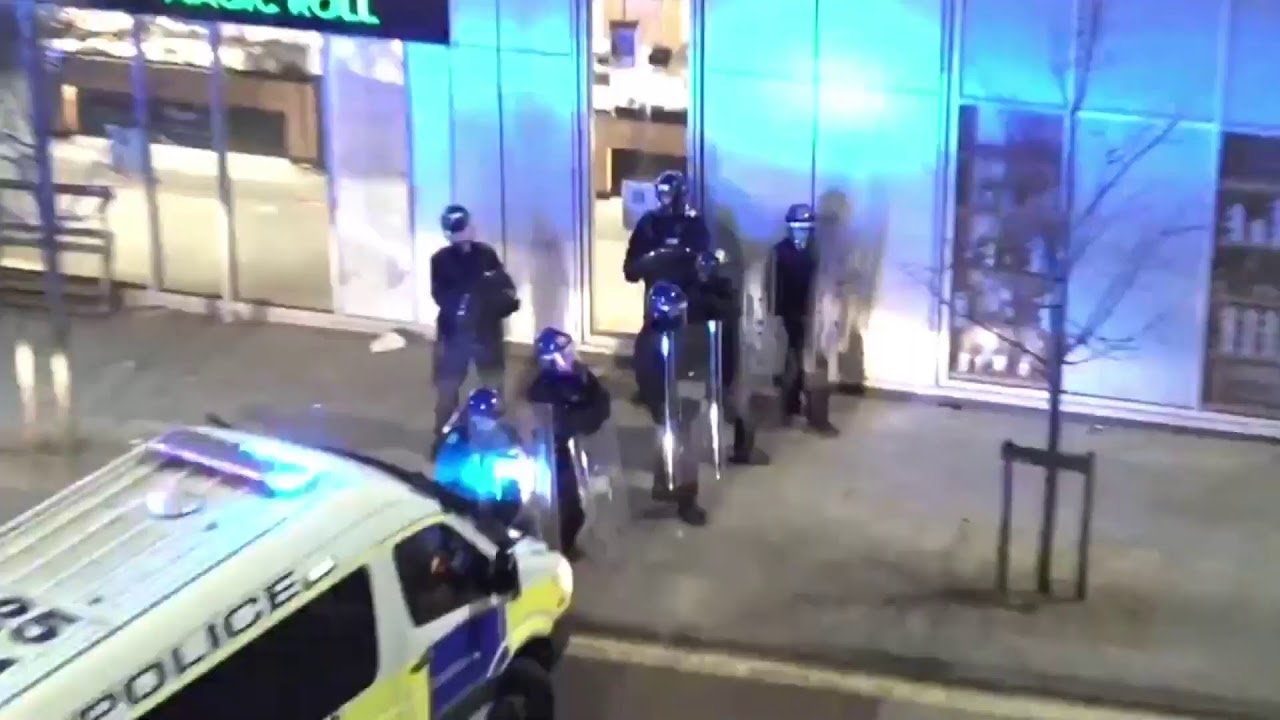In this video I think it's demonstrated incredibly powerfully what importance needs to be placed upon anti-horse tools.
The horses do the bulk of the work in creating space that allows the police line to tighten the noose here. Without them they never would have controlled these crowds with people on multiple sides of them. They could not have maintained control.
There must be simply and effective methods to spook these horses without causing a danger to them. Something that could be deployed that would make the riders tell their superiors "we can't deploy because the horses would be spooked by x".
Anyway. What are other people's thoughts here? Obviously this protest was unprepared for a fight (although several police have been hospitalised). What could small groups of 1-5 have done in the wider engagement to make things go differently?


Footage of a more agressive charge for reference
A cursory glance at Wikipedia suggests holding your ground in a close-knit formation is the strat. Granted that requires a hell of a lot of discipline and prep across a lot of people.
The problem is, the discipline required mandates significant training with a group. There's a reason that even though pikes were around as a weapon, cavalry was still effective for centuries after the first medieval pike victories. Edit: to expand a little, the effective early pike users of the medieval era were Flemish & Swiss militias, who drilled and trained together repeatedly, and the Scots, who I assume were just pissed enough at the English to not break. Eventually everyone adopted the pike & drill as the answer to cavalry. The pike mutated and shrank over the years as infantry firepower increased, eventually becoming the plug, then ring bayonet. It turns out even a 5-6 foot long wooden stick with a knife on it, which is what a musket & bayonet is, is sufficient in well drilled hands to deter cavalry. (Any hints taken about the size & design of the sticks your protest signs are mounted on are completely left to your own imagination).
That's a big ask for folks you might have met an hour before, and also why traditionally cavalry was the urban anti riot solution.
Effective defenses against them in an urban situation relied on barricades and channeling the cavalry into alleys, where the cavalry could be flanked and Minecrafted. In addition, especially in older European cities, dropping roof slates onto the cavalry was the urban worker's answer. Helmets don't matter when ten pounds of stone lands on your head. I can't recall if the "stretch a rope across a street" idea ever happened or if my memory is filling in gaps with Looney Tunes cartoons.
Edit: I did mention barricades. To expand on some thoughts I've had about that, organized groups of protesters should start practicing using cars & trucks for barricade & escort duty, particularly since "driving into the crowd" attacks were pretty common last summer and will likely only become more frequent. So , a few cars at walking speed ahead of the protest to block off intersections they pass through, with other groups behind and on parallel streets.
(Thank you medieval history degree I rarely use)
Some things never change! As long as we live, people will probably be tussling with cavalry.
Yep, folks use cavalry because it works.
As for the stretched cable, I know chilean protesters used a cable attached to fixed anchors to stop a literal APC. I'm not sure how well it would work against horses
It’s extremely easy to stop and halt APCs. Obscure all vindows and vision blocks. Certain barricades they will get stuck on. They need a lot of room to move and turn wide so channeling them into tight specs helps. A big APC is scary but if you can get people on it or near it then you will be able to damage radio equipment, lights, and people’s ability to use it.
I remember seeing something about bringing a spool or two of fishing line and laying it at ankle/knee height to prevent charges like this. It'll trip up unmounted cops and break their advance, but don't know how well it would work with mounties. Would the horses get tripped up/spooked by fishing line?
Bonus for this tactic, if they're using smoke/tear gas the line is essentially invisible and after two or three instances of eating shit because they charged into line, they'll start slowing their charges even without line.
I think tripping them would depend on how heavy the line is and how well secured it is, as well as what the horse is doing. The kinetic energy of a horse at gallop is... impressive.
I think someone who has more personal experience with horses would be better able to answer if it would spook them.
Edit: I suppose more of a net arrangement with cans on the end could be effective, as the horse's legs would be entangled and the noise would follow them, which should spook them.
Although I mentioned in another answer below, horses in a blind panic are incredibly dangerous. If one panics into a crowd at full speed, people will die, between the horse & the ensuing crowd stampede and possible crush. Human stampedes are deadly! The Hillsborough disaster killed 96 people, for example.
This was actually a concept I discussed in a thread when I was looking at potential ways to prevent the American cop charges. Those charges rely on the energy of the rush to spook undisciplined protesters and basically anything on the ground between the protesters and cops would prevent the cops from rushing with the energy they want to.
Even after months of military training it was hard to get guys to walk in formation correctly. Let alone a bunch of “civilian” (for lack of a better term) protestors who don’t have that time, training or commitment.
This is the key. Think of it this way: somehow you find a bunch of large poles at a protest and think "hmm, I know pikes were used against cavalry. These poles are essentially pikes. Let's grab them!"
Across the square, you see cops on horseback. "Great! We've got the weapons to take them on!". You and the other people who grabbed the poles make your way to the front of the crowd, and prepare to receive charge.
The horses advance. And how come you couldn't tell from across the square how big the horses + riders are? It's like 7-8 feet from their hooves to the riders helmet!
Still, you're holding a 12 foot pole, and you can do math. You can definitely hold off the horses! You and the people you...just...met...20 minutes ago? You know you will definitely hold your ground, right? But what about the person next to you? And the person next to them? And those horses are getting even larger, and you can hear the metal shod hooves...and you know you'll catch charges if you attack the horse or rider and are caught afterwards...and that person next to you is starting to shake a bit...
If only there was a dedicated group or party of people to instill discipline and organize the working class. A vanguard if you will.
Interesting. This is basically depicted in the video you linked from 2010. When the protesters come back and are too tightly bunched up the horses will not challenge the dense crowd and back up.
This is presumably why police only use horses as loose attacks. They break up a crowd forcibly taking space from protesters and then immediately deploy police with shields in front of the line of horses, the horse line then sits behind the police line. Horses can't hold their own line against a dense crowd.
From that perspective the horses are just a force-multiplier, and the primary objective of protestors is resisting/defeating the dismounted cops. Either way the thing is organisation, prep, and discipline.
Yeah I see that too. But in circumstances like this it's not really about "defeating" the police but about protecting the protesters. In a crowd that does not want to have an all out fight with the cops you can't just beat the dismounted cops. The only effective tactic as I see it is to defeat their ability to do what they want to do, and in this case it is to use the horses to herd the protesters into an easily controlled space and then to keep them there for however long it takes to mop up smaller numbers of protesters not caught in the kettle.
What the protest needs to do from that perspective is to be spread in such a way that cops don't have the resources to maintain any kind of control however you can't get an entire protest to act as a collective like that (without many months of fighting the state for experience) so in this case you're left with the question of "what can small groups of 1-5 people do in this scenario to change the outcome of things?"
Right, I see what you mean. I'm intrigued by the huge blue tarp approach mentioned in another comment thread.
Interestingly if you google "horse won't walk on tarp" you get a tonne of training videos. It does look like it takes very conscious effort to train them into it and they still don't like it.